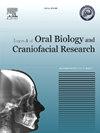Worst pattern of invasion in oral squamous cell carcinoma: An independent prognostic indicator
Q1 Medicine
Journal of oral biology and craniofacial research
Pub Date : 2025-04-10
DOI:10.1016/j.jobcr.2024.12.008
引用次数: 0
Abstract
Introduction
Oral squamous cell carcinoma is a malignancy that is biologically aggressive.
Objective
To investigate the correlation between various histopathological factors and the worst patterns of invasion at the tumor-host interface, which were classified as cohesive (1–3) and non-cohesive (4&5).
Methods
Neck dissections were performed on 81 cases of oral squamous cell carcinoma those had been diagnosed. The selection was limited to paraffin-embedded blocks that contained sections from the tumor. Tumor staging, nodal staging and other factors such as lymphovascular invasion, perineural invasion, extra nodal extension, depth of invasion, margin status and tumor differentiation grades were documented.
Results
The findings indicate a higher frequency of non-cohesive worst invasion patterns in numerous anatomical sites. A prediction accuracy of 69.1 % was obtained from the logistic regression analysis, suggesting that the predictive performance has also improved. The chi square test results demonstrated a statistically significant correlation between the variable of interest and extranodal extension showing a p value of 0.008 while lymph node status also showed significant with a p value of 0.000. Another factor that depicted a significance with worst pattern of invasion was tumor margin status having a p value of 0.046. Lymphovascular invasion and the worst pattern of invasion also exhibited a statistically significant correlation, with a p-value of 0.013.
Conclusion
The results of this investigation indicate that aggressive tumor biology is associated with non-cohesive worst pattern of invasion. Non-cohesive worst pattern of invasion is associated with moderate differentiation grade, lymphovascular invasion, perineural invasion, extranodal extension, closed or involved tumor margins and nodal metastases.
口腔鳞状细胞癌最坏的侵袭模式:一个独立的预后指标
口腔鳞状细胞癌是一种具有生物侵袭性的恶性肿瘤。目的探讨各种组织病理学因素与肿瘤-宿主界面最严重侵袭模式的相关性,将其分为内聚性(1-3)和非内聚性(4&5)。方法对81例经诊断为口腔鳞状细胞癌的患者行颈部清扫术。选择仅限于含有肿瘤切片的石蜡包埋块。记录肿瘤分期、淋巴结分期及其他因素,如淋巴血管浸润、神经周围浸润、淋巴结外延伸、浸润深度、边缘状况、肿瘤分化等级等。结果研究结果表明,在许多解剖部位,非内聚性最严重侵犯模式的频率较高。逻辑回归分析的预测精度为69.1%,表明预测性能也有所提高。卡方检验结果显示,利息变量与结外延伸之间的相关性具有统计学意义,p值为0.008,淋巴结状态也具有统计学意义,p值为0.000。另一个具有最坏侵袭模式意义的因素是肿瘤边缘状态,p值为0.046。淋巴血管浸润与最坏浸润方式的相关性也有统计学意义,p值为0.013。结论肿瘤的侵袭性生物学与非内聚性恶性侵袭模式有关。非内聚性最严重的侵袭方式与中等分化程度、淋巴血管侵袭、神经周围侵袭、结外延伸、闭合或累及肿瘤边缘和淋巴结转移有关。
本文章由计算机程序翻译,如有差异,请以英文原文为准。
求助全文
约1分钟内获得全文
求助全文
来源期刊

Journal of oral biology and craniofacial research
Medicine-Otorhinolaryngology
CiteScore
4.90
自引率
0.00%
发文量
133
审稿时长
167 days
期刊介绍:
Journal of Oral Biology and Craniofacial Research (JOBCR)is the official journal of the Craniofacial Research Foundation (CRF). The journal aims to provide a common platform for both clinical and translational research and to promote interdisciplinary sciences in craniofacial region. JOBCR publishes content that includes diseases, injuries and defects in the head, neck, face, jaws and the hard and soft tissues of the mouth and jaws and face region; diagnosis and medical management of diseases specific to the orofacial tissues and of oral manifestations of systemic diseases; studies on identifying populations at risk of oral disease or in need of specific care, and comparing regional, environmental, social, and access similarities and differences in dental care between populations; diseases of the mouth and related structures like salivary glands, temporomandibular joints, facial muscles and perioral skin; biomedical engineering, tissue engineering and stem cells. The journal publishes reviews, commentaries, peer-reviewed original research articles, short communication, and case reports.
 求助内容:
求助内容: 应助结果提醒方式:
应助结果提醒方式:


